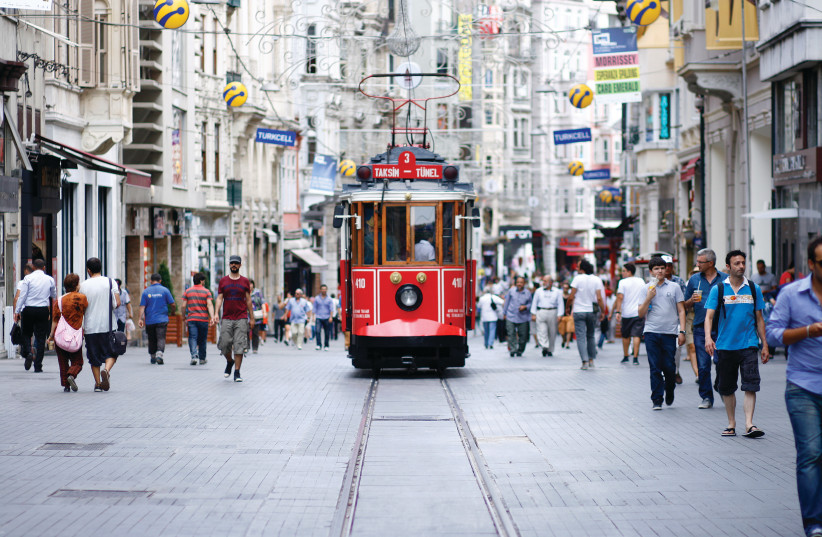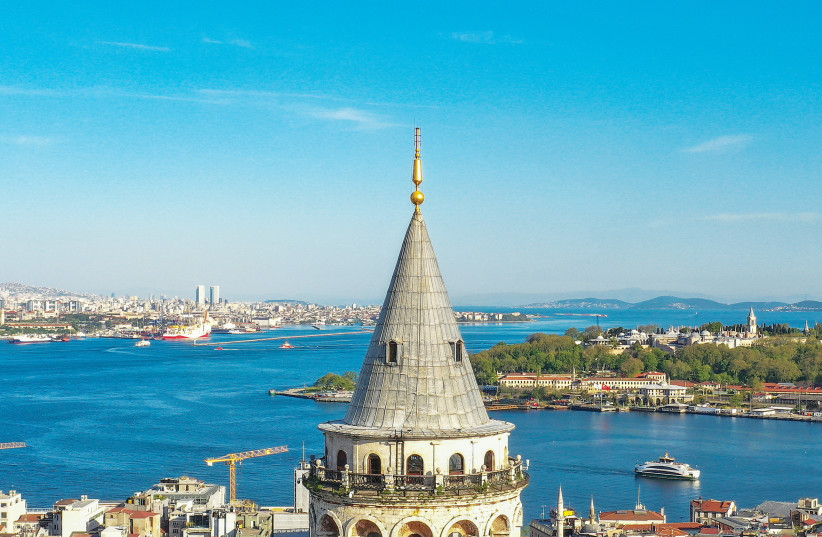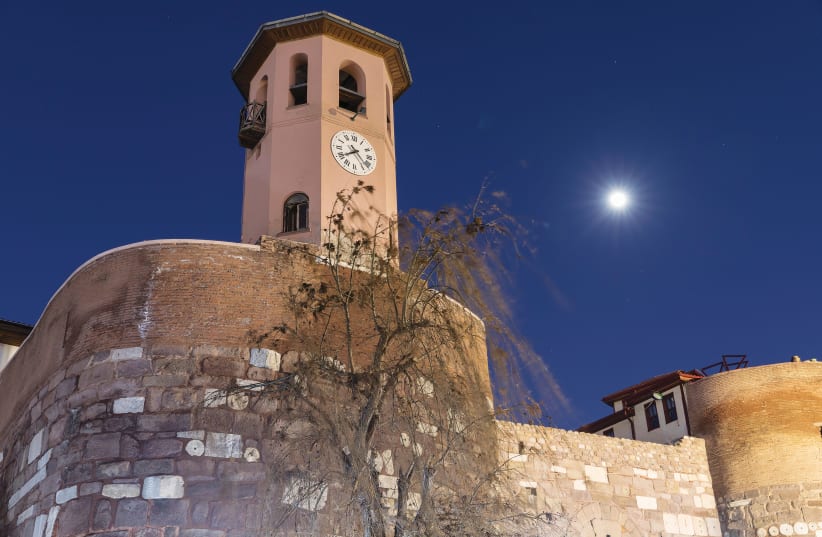While most Israelis go to Turkey for shopping or an “all-included” pool-side vacation, the country has much more to offer. As travel warnings to Turkey were lifted and relations between Turkey and Israel are warming up, it is time to catch a short flight to this exciting destination.
The Turkish Culture and Tourism Ministry organizes culture festivals across the country offering locals and visitors a chance to experience the rich local heritage as well as many musical and artistic offerings from around the world.
We were in Turkey for the annual Beyoglu and Baskent festivals that connect the capital Ankara with Istanbul and take place in both cities during May and June.
The fall edition of the cultural festivals take place between October 1-23, and next year the beautiful city of Izmir will also be a part of the cultural festivals. The festivals present Turkey’s cultural heritage as well as the lively current scene.
Istanbul
While any trip to Istanbul should start with a short boat ride on the Bosphorus at sunset (preferably with a glass of wine and some music), and include a visit to the famous covered market and the Hagia Sophia mosque, the Topkapi Palace, as well as the fantastic shopping on the Istiklal pedestrian street, there is much more Istanbul has to offer, especially to those interested in history and culture.


Beyoglu is the name of Istanbul’s nightlife quarter located in the center of the city. The culture route named after the quarter goes through some of the city’s staple sites – such as the Galata tower and museum; the Ataturk culture center, which was renovated recently and holds the Opera, as well as the national library; the Tarik Zafer center; and the cinema museum, which is a lot of fun for enthusiasts and children alike.
We started at the Ataturk Cultural Center – AKM, located on Taxim Square. The iconic building renovated in recent years, boasts a huge, round, red semi-hemisphere, covered with 40,000 handmade, dark-red ceramic tiles. The curved red wall is the entrance to the concert hall, home of the Turkish national orchestra and opera. The center is also home to the national theater, galleries, library, children’s art center and a very impressive digital art display by Rafik Anadol. Do not miss it.
On the other end of Istiklal is where you’ll find a line of visitors waiting to climb up the famous Galata tower, one of the oldest towers in the world, and a symbol of Istanbul.


The Galata Tower was first built by the Byzantine Emperor Justinianos in 507-508 CE, and then rebuilt by the Genoese in 1348-49. The 67 meter-high tower sits at the highest point of the city and the balcony at the top provides a 360 degrees view of the city and a fantastic selfie spot. You go up on an elevator that only goes up, but do not despair. Walking down the stairs you will discover the beautiful building technique and many interesting exhibition areas.
Connecting the two squares is the famous pedestrian shopping street Istiklal. The long stretch is famous for excellent shopping, picturesque alleyways studded with cafes and restaurants, including the famous “mastic” ice cream vendors that stretch the ice cream and keep their crowds happy, kebab and sweet shops, that sell the best Turkish delight and many other attractions for the whole family.
But there’s more to this central street, such as the Istanbul Cinema Museum (Atlas Cinema), a wonderful break from the hustle and bustle that kids and movie buffs will adore. Sharing nostalgia-loaded scenes from Turkish movies as well as memorabilia, this neoclassical building has impressive ceiling decorations, marble fireplaces, and plaster reliefs. The first two floors of the museum hold a permanent exhibition, and the third hosts temporary art exhibitions. Kids and movie enthusiasts will love the life-size wax figures of actors and actresses as well as a chance to “star” in or direct a Turkish film using a green screen.
Not very far from there, you can find the Galata Mevlevi Museum, the most famous Mevlevi Whirling Dervish hall. The Whirling Dervishes took their name from Jelaleddin Rumi (1207-1273), the mystical poet and great Sufi master, called Mevlana (our leader) by his disciples. Sufis seek a close relationship with God, and for Mevlana, it was through chants, prayers, music and a whirling dance. This ceremony (sema) can be witnessed by visitors. Keep in mind though that although it may look a bit like a performance, it is still a religious ceremony.
The Galata Mevlevi Museum, or Tekke, is located on Galipdede Caddesi, not far from Tunel at the end of Istiklal Caddesi. You can only buy tickets on location starting Saturday around noon. With a maximum capacity of 150 people, the performance is often sold out.
The newest and maybe most interesting sight in town these days is the Galataport in Istanbul. The newly opened port services huge cruise ships that frequent the Bosphorus. The whole area was renovated and rebuilt and now offers many restaurants, high-end boutiques, design centers and galleries, well worth the visit. The city’s modern art museum is located here and there are many resting spots and wonderful photo opportunities. There’s an impressive underground passenger’s terminal that can cater for many cruise ships, and there is an interesting tour showing the terminal.
Ankara
Most tourists arriving in Turkey never go to Ankara, the country’s capital. Located in the central part of Anatolia, many of the city’s residents are government employees and diplomats.
Established as the capital of modern Turkey by Mustafa Kemal Atatürk upon the establishment of the Republic on October 29, 1923, Ankara is also an important commercial and industrial city located at the center of Turkey’s road and railway networks. The city, which by the way gave its name to the Angora wool, was once a stopping point for travelers to Jerusalem.
Ankara is quieter than Istanbul, but the city offers many cultural and historical sites, including the Ata Turk mausoleum – a huge park and museum not to be missed. The cultural festival, by the way will come back here during October.
Ankara Kalesi (castle) was built in 620 CE and the walls surrounding it are from the seventh century. The Ottoman village surrounding it is very pretty and the small houses and alleyways became galleries, gift shops, artists’ studios and cafes. A few stores seem more authentic than others, selling soaps, wool and anything you may need. I found a few pretty gifts there and even got some hand-woven angora wool.
Part of the castle is devoted to the Museum of Anatolian Civilization, showing a rare collection of archaeological findings. The gardens surrounding the castle offer a very welcome breaks.
On another part of the city, one of my favorite spots in Ankara was the ethnography museum – offering rare exhibitions of Ottoman calligraphy, traditional dresses and head jewelry, rare ancient ceramics, glass and wood artifacts, as well as rare carpets.
Just next to it is the modern art gallery where you can see interesting collections of Turkish modern art dating from the beginning of the 20th century until today. For art lovers, it is an opportunity to learn more about the lively are scene of Turkey not very well known to most of us.
The musical campus of Ankara, the CSO Ada Ankara (Presidential Symphony Orchestra Concert Hall) is a modern building that hosts the symphonic concert hall. The beautiful complex houses the main concert hall, as well as a few smaller halls, and the orchestra building. Outside there’s an open-air concert area and the CSO Museum, presenting changing exhibitions.
Another Ankara landmark is the Atakule communication and observation tower. This 125 meter-high tower, located in the Cankaya district of central Ankara, can be spotted from almost anywhere in the city. The top section of the tower houses an open terrace and a revolving restaurant named Sevilla, which makes a 360-degree rotation in one hour. Drinking our coffee up there, we enjoyed the breeze and the ravishing sunset. Below the tower there is a shopping mall with more restaurants, upscale shops and art galleries.
Not part of the culture route, but an absolute must-see for anyone visiting Ankara, is the Ataturk Mausoleum, designed by Turkish architect Emil Onat, and constructed between 1944 and 1953. It is the final resting place of Mustafa Kemal Ataturk, the founder and first president of the Turkish Republic.
Visits are regulated and many locals come here to pay their respect, honor their beloved leader and learn. The complex is huge and has a grand staircase known as the Path of Honor, leading up to the Court of Honor where the mausoleum itself and a museum dedicated to Ataturk’s life both sit.
The Ataturk and War of Independence Museum, located under the Hall of Honor, covers both Ataturk’s life and the founding years of the Turkish republic.
The writer was a guest of the Turkish Ministry of Culture and Tourism
